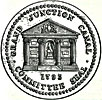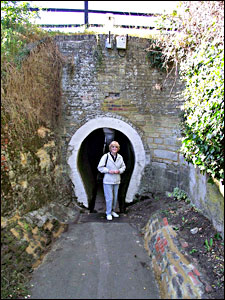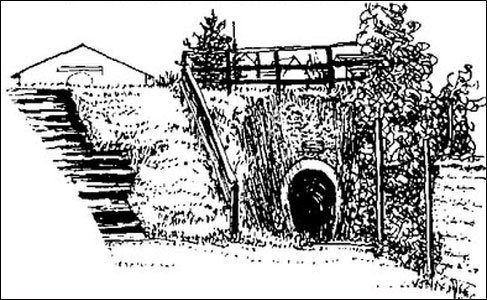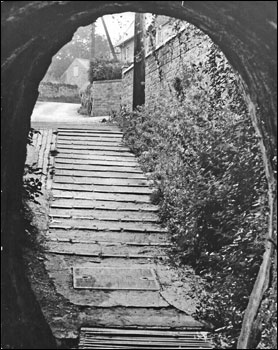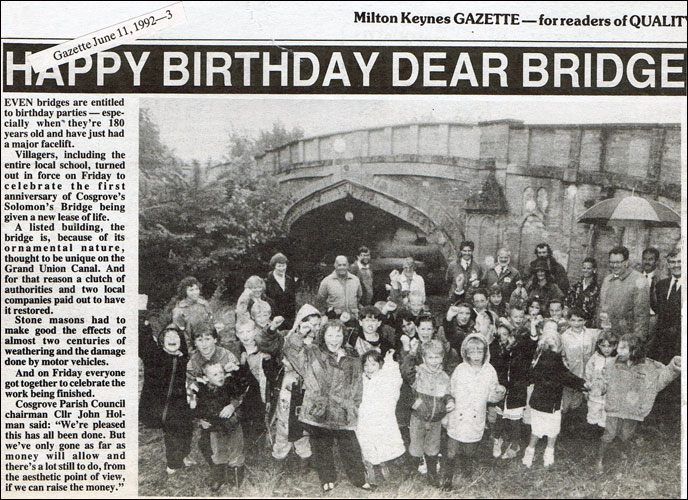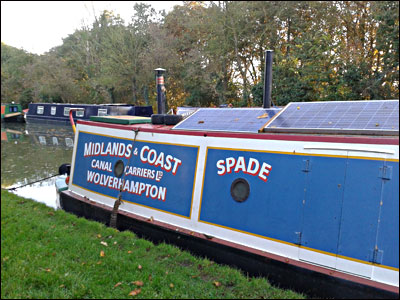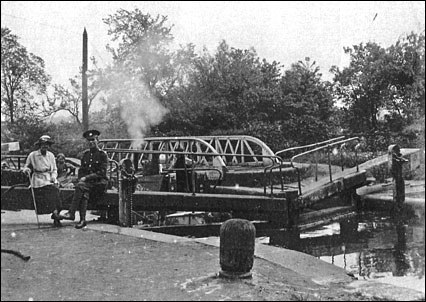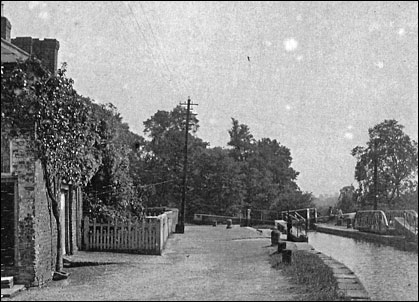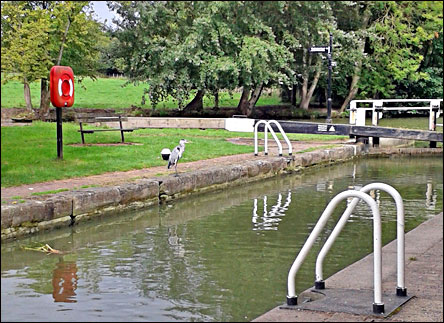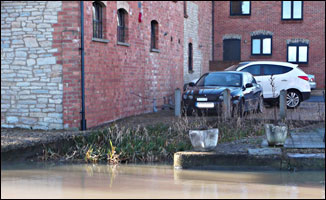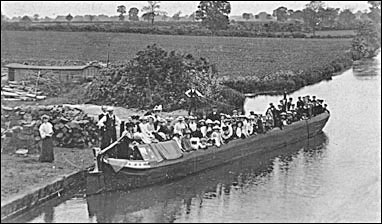|
||||||||||||||||||||||||||||||||||||
From Stoke the canal descends through a flight of seven locks to reach its next level, the 5½-mile Cosgrove pound; only the lock at Cosgrove separates it from the adjoining Fenny pound.
The main line passes through Cosgrove village, following the right bank of the Tove to near its confluence with the Great Ouse. Before the advent of the canal, Cosgrove’s main access road came south from what is now the crossroads to the Barley Mow public house, where it turned left and ran straight down from there to the Green. The canal was built at right angles right across this Main Street, being carried on what was then called The Aqueduct (not to be confused with the Iron Trunk). Under this Aqueduct a tunnel was built for horses to walk through to the Blacksmith’s yard and stables behind the Barley Mow. Running from the Church, between the churchyards to the west side of the Horse Tunnel is a railed pathway called the Coffin Walk. It is believed locally that this was constructed to carry the dead from canal boats to their burials. It is now part of the Grafton Way long distance path.
The Bridge
Meanwhile a bridge, number 65, variously called the Ornamental Bridge, Samson’s Bridge and Solman’s Bridge, was constructed to carry a road (Bridge Road) for livestock and road traffic from the crossroads across the new canal to the Priory, and turning right, down to rejoin Main Street where it started again east of the canal. There are various local theories about why Cosgrove has one of the only two stone ornamental bridges on the Grand Junction (Union) Canal. None of these is supported by documentary evidence. However, the Bridge is now a Grade II Listed Monument and its listing is given below:
Although Colonel Solmans is yet to be traced, George Biggin is described in our Cosgrove Characters section and from this his eccentricity and imagination can certainly be confirmed!
The Bridge has survived dreadful ill treatment, including carrying over 50 gravel lorries a day for months during the extraction of sand and gravel from the Cosgrove Park area for the construction of the M1 motorway, and almost annual assaults from wide loads. Its sandstone carving suffers erosion and weathering all the time, but it is perhaps the best loved symbol of Cosgrove to this day.
In February 1996 the Parish Clerk explained the controversy over the name of the Bridge in the local newsletter “The Old Mail”.
The Boaters The Grand Junction Canal shared the fortunes of the canal network in general. Its trade was badly damaged by the railways, for although the tonnage it carried remained fairly buoyant for many years, it did not share in the greatly increased volume of freight carried by rail, while what it did carry was at greatly reduced rates. In 1929 its owners amalgamated with other canals to form the Grand Union Canal Company, but the new company continued to experience mixed fortunes, its trade not being helped by WWII. Whether nationalisation in 1948 was of benefit or not is a matter of conjecture; suffice it to say that the waterway survived into the age of leisure boating and a sustainable future. Cosgrove now has a close knit community of permanently moored boaters, as well as thousands of waterways visitors every year who stop to photograph the Bridge, use the amenities, drink in the Barley Mow and become, briefly, part of the village. In 2003 Cosgrove Church held a Waterways Service at the Lock to include the Boaters in the village community. On Sunday 1st June The Maryem, Panda 2 and The Brian tied up, by invitation, in the space reserved for the Linda near the Lock gates. Each was carrying the banner of the CHRISTIAN BOATER’S FELLOWSHIP and were bedecked in red balloons supplied by British Waterways. When the Rector and our organist arrived at 11am they were welcomed by a crowd of more than 100 people. Including boat people (resident and visiting), villagers and holiday makers. Rector Leslie raised a laugh when he said that he never thought that he would ever have the opportunity to step on to a boat to move away from the crowd! Before the service started we were entertained by members of the WOADWORKS MORRIS a group who meet in the Village Hall every week. They had expressed a wish to play their part in a village activity. Roger was invited to use an electronic keyboard supplied by the Maryem and he accompanied the singing of some very joyful hymns, including the boater’s version of psalm 23. Leslie welcomed the opportunity to bring the two parts of our village together. He blessed the waterways, the boats, the residents and the visitors and prayed that we may all share the community life of the village with each other in growing friendship and commitment. At the end of the service the Morris Dancers gave us another dance and as the last note on their drum was played, the Church bells of St. Peter and St. Paul rang out from the top of the village. Led by our community policeman, the Rector, several children in canal dress and the dancers everyone walked along the towpath to the bridge and along Bridge road and Stratford road to the Church gates. In the shade of the Church grounds refreshments were ready, including an iced cake made and decorated with the bridge by Katie. Inside the Church Roger provided organ music for those who preferred the cool of the north aisle and outside the dancers persuaded onlookers to join the dance. The Rector, the policeman and the churchwarden took up their staves and joined in to the applause of all! Our aim was to take the Church to the community and bring the community to the Church and on a beautiful summer’s morning that is what we tried to do!
The “Spade” was one of the oldest boats mooring at Cosgrove in 2013. The Lock
Brewery
Thrupp Wharf A public wharf was established about half a mile north of Cosgrove, where the road to Castlethorpe crossed the canal. This is Castlethorpe Wharf (Thrupp Wharf), and it hosts a public house, the Navigation Inn. When the Inn was put up for sale in 1876, the wharf was described thus:
Sources Wikipedia “The Grand Junction Canal” Alan H Faulkner 1972 The Old Mail http://www.buckinghamcanal.org.uk/history-and-heritage/surveys-of-the-arm/#histnotes http://gerald-massey.org.uk/Canal Ian Petticrew and Wendy Austin | ||||||||||||||||||||||||||||||||||||


